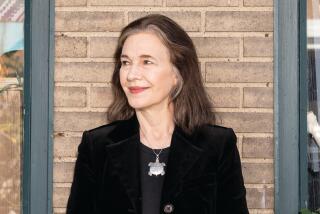Wilderness ‘Matriarch’ Sows the Seeds of Conservation
- Share via
GRAND TETON NATIONAL PARK, Wyo. — Strangers still find their way to Margaret Murie’s log cabin at the end of a gravel road.
Some have read books that she wrote decades ago; others have heard stories of her long career as a conservation activist. All hope to meet the woman known as Mardy, considered by many the mother of the modern wilderness movement.
“I have seen people walk away from visiting with her as though they had been visiting a shrine,” says son Donald. “Even now, stuck in a wheelchair and not always entirely with it, she has a force of personality that is very effective.”
Bill Meadows, head of the Wilderness Society, says, “There are a handful of people we count among our legendary heroes. Within the wilderness family, Mardy is still considered the matriarch.”
Murie turns 100 on Aug. 18 and still lives within Grand Teton National Park on the ranch that first became a center for the conservation and wilderness community in the 1940s.
This is where her late husband, Olaus, established an office when he took a lead role with the Wilderness Society.
On the front porch of the modest cabin, tucked under towering evergreens and just minutes from the crush of tourists, the Muries used to meet with conservation and scientific luminaries and helped sow the seeds of what became the federal Wilderness Act.
Mardy Murie served both as hostess -- she was a great cook with a keen sense of humor -- and secretary. She also was known to speak her mind, friends say.
Olaus Murie died in 1963. Age and illness have slowly robbed Mardy Murie of the enthusiasm with which she once greeted even unannounced visitors to the ranch. The tradition of cookies and conversation has been retired.
Caretakers look after her now, sometimes turning away visitors. Wilderness activists and other friends make sure that Murie’s bills are paid, that her cabin is maintained and that her needs are met.
And they say they are determined to make sure the movement continues long after her death.
An education center, a conservation think tank, is planned on the ranch to raise a new generation of wilderness advocates.
Renovation is underway on the ranch’s historic cabins and outbuildings, designated a national historic district and bequeathed to the National Park Service when Murie dies.
Mardy Murie’s life as a conservationist began in earnest after she and Olaus married in 1924. The two embarked on a life of travel and scientific exploration.
For years, Olaus worked as a biologist with state and federal agencies, exploring unmapped areas and studying wildlife. His work led them to Alaska, and they were credited with helping preserve the area now known as the Arctic National Wildlife Refuge from oil and gas development.
They reared three children, although Donald Murie, now 70, says his parents never let child-rearing get in the way of their quest.
“When they went off to do a study for a week or two, we went along and slept on the ground in tents,” says Donald Murie, who lives in Palm Springs. “A lot of times we resented it. They were good parents, but we always realized this work they were doing was No. 1.”
In 1998, his mother’s lifelong conservation work won her the Presidential Medal of Freedom. But Mardy Murie anguished over her role in the conservation movement after her husband’s death.
“I think it would have been hard for her to do anything after that,” says close friend Inger Koedt, 87. “But it was important for her to have an influence.”
Often, her biggest influence was on those who followed the narrow road to her cabin and had cookies with her. Friends say she relished sharing her experiences with visitors in hopes of engaging them in the fight to preserve wilderness.
“There is a higher purpose for these lands than oil and gas development, she figured. There is a soul purpose,” says Louisa Wilcox, a conservationist from Bozeman, Mont., who has known Murie for 20 years. “She made you think a lot about your own motivation: Is your heart pure? Hers was.”
Bruce Hamilton, national conservation director for the Sierra Club, says the wilderness movement has not lost its passion or its goal. It simply has become far broader and more diverse in the issues and politics involved.
Meadows agrees, and he adds that there is plenty to learn today from such early wilderness warriors as Murie -- including a better understanding of opposing views.
“We’ve let politics influence our arguments more than we should,” he says. “And we should look at ways to build bridges. Some believe there is a need to move away from the political campaign of the 20th century and to a spiritual campaign of the 21st century.”
That emotion -- connectiveness -- is what Murie got across and what Wilcox says inspired activists like her: “She related to wilderness as a beautiful, spiritual place that we needed more of for our soul.”
More to Read
Sign up for Essential California
The most important California stories and recommendations in your inbox every morning.
You may occasionally receive promotional content from the Los Angeles Times.













